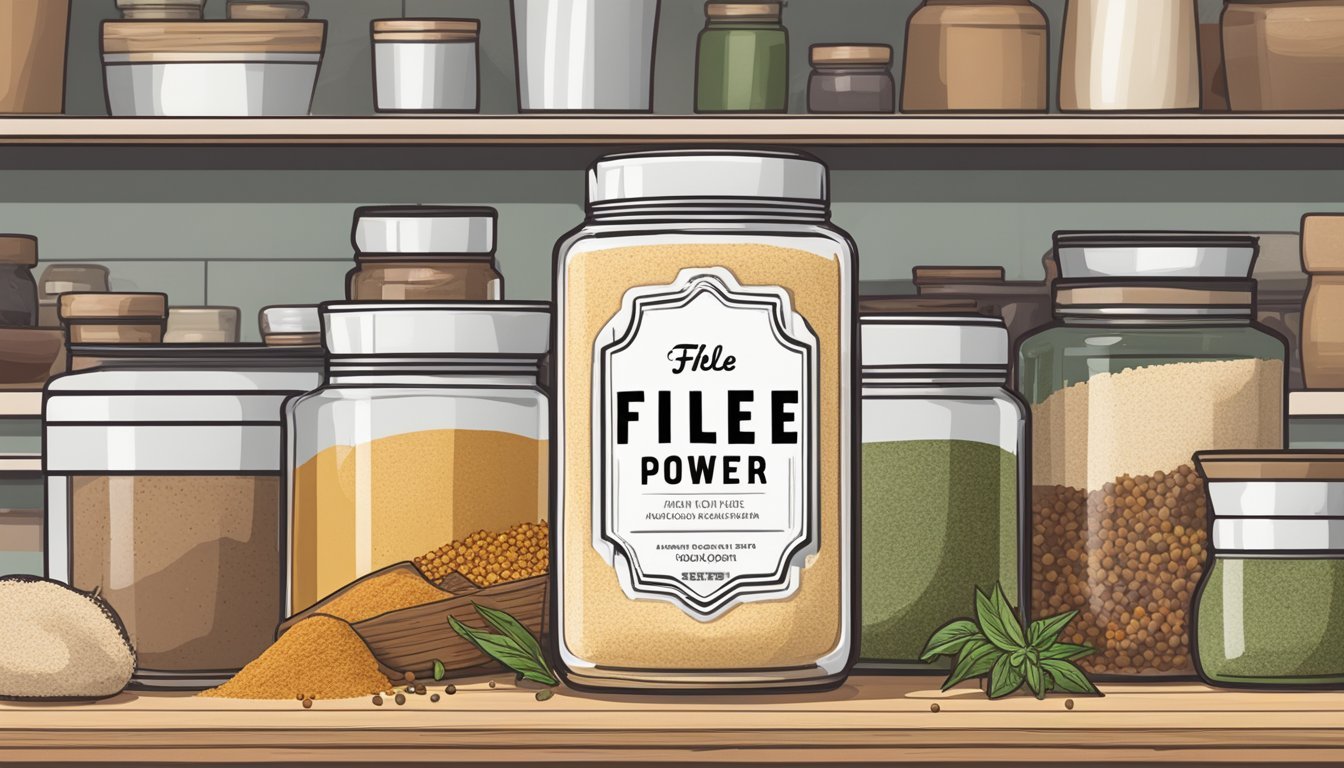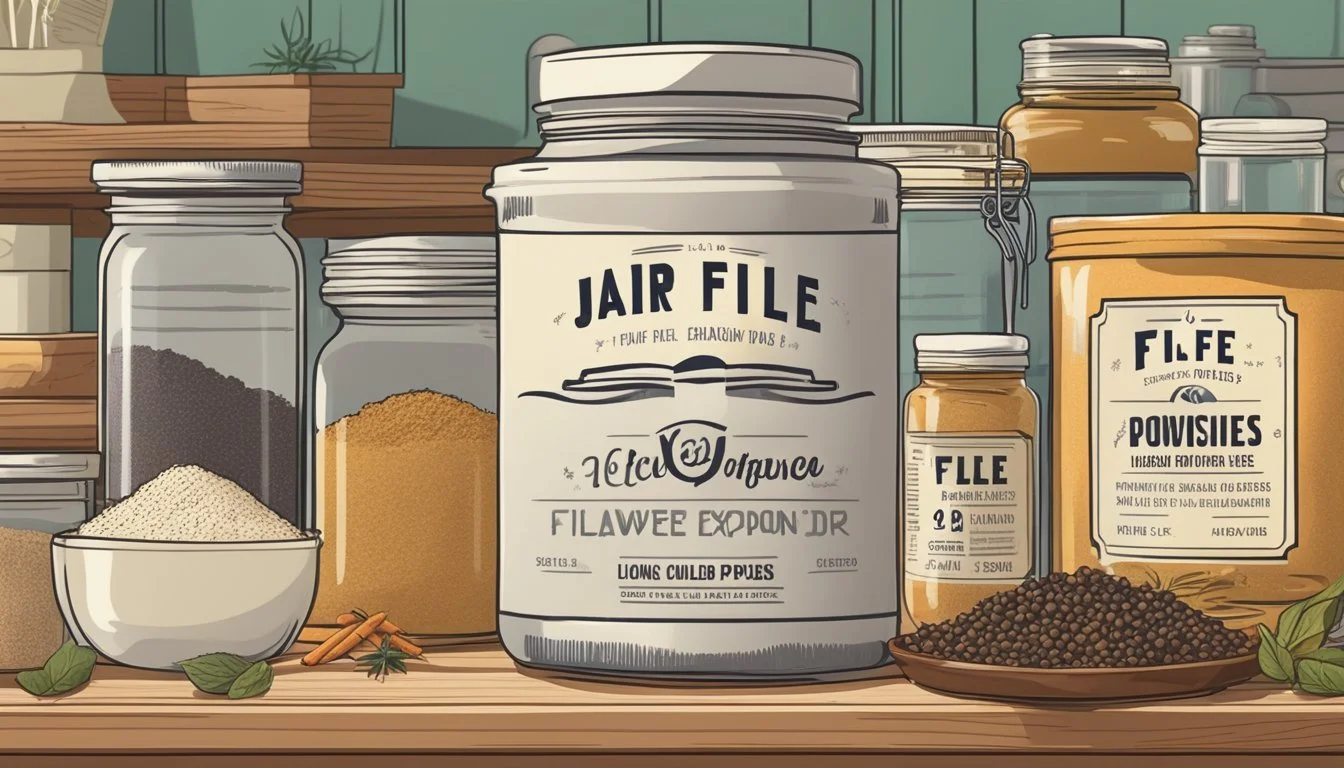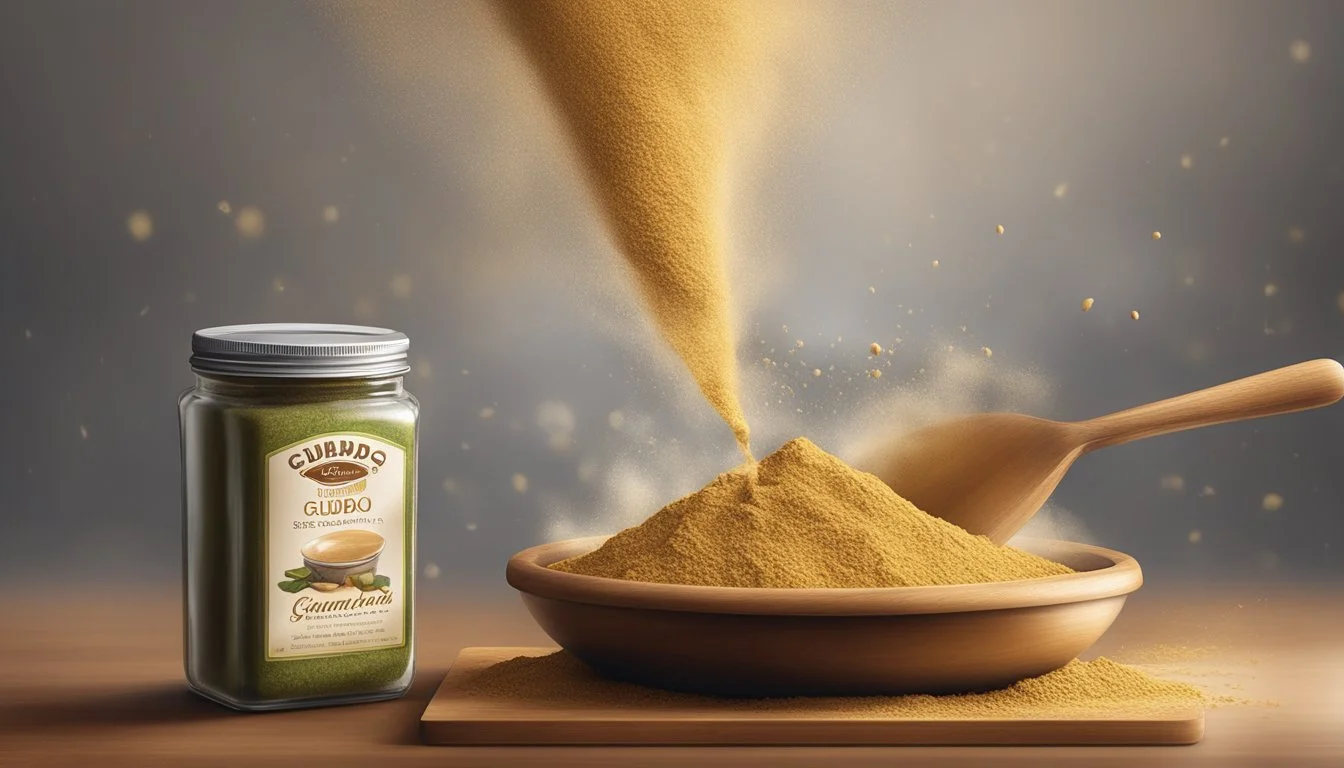How Long Does Filé Powder Last?
Shelf Life and Storage Tips
Filé powder, also known as gumbo filé, is a seasoning with both culinary and cultural significance, primarily used in Louisiana Creole cuisine. Made from the dried and ground leaves of the sassafras tree, filé powder not only imparts a distinctive flavor to dishes but also acts as a thickening agent. It’s most famously added to gumbo, the quintessential stew that symbolizes the melting pot nature of Creole cooking.
The shelf life of filé powder, like many spices, is finite. It is best used within a year to eighteen months for optimal flavor and efficacy, although it can remain safe to consume for much longer. Over time, filé powder may lose its potency and become stale, particularly if it’s not stored correctly. Keeping the powder in an airtight container, away from heat and light, can help preserve its quality.
Adding filé powder at the end of cooking is a traditional method, as prolonged heating can cause the stew to become stringy and affect the desired texture of the gumbo. This, paired with its storage and freshness, underscores the importance of understanding how long filé powder lasts to maintain the integrity of the dish it’s meant to enhance.
Understanding Filé Powder
Filé powder is a distinctive seasoning derived from the sassafras tree, essential in Louisiana Creole and Cajun cuisines. It not only thickens but also adds a unique flavor to dishes.
Origins and Composition
Filé powder, known historically by the Choctaw Indians and incorporated into Louisiana Creole cuisine, originates from the dried and ground leaves of the sassafras tree. The word "filé" comes from the French word "fil," meaning thread or filament, indicative of its thickening properties. The sassafras leaves are key, yielding a spice that carries a complex flavor profile, slightly sweet and somewhat spicy.
Culinary Uses
In the culinary world, filé powder is renowned for its application in Creole gumbo, a staple of Louisiana Creole cuisine. The powder serves as both a seasoning and a thickening agent, commonly added after a dish has finished cooking or just before serving to prevent it from becoming stringy. This is distinct from other thickeners like roux, which is cooked with the base of the dish. Gumbo filé imparts a sense of authenticity specific to Cajun and Creole dishes, and its usage is deeply rooted in tradition, reminiscent of the rich culinary heritage of Native Americans and French settlers in the Americas.
Storage Practices
Proper storage is key to maintaining the shelf life and quality of filé powder. Factors such as environment and container choice significantly influence its longevity and texture.
Environmental Factors
Filé powder's shelf life is greatly affected by environmental conditions. It should be stored in a cool, dry place away from heat sources and out of direct sunlight. Exposure to high temperatures and humidity can lead to clumping and loss of flavor. Air is also a concern as it can lead to the degradation of quality over time. To preserve the powder's earthy-fruity flavor profile and prevent the texture from becoming goopy, control of moisture and air is essential.
Container Types
The ideal container for storing filé powder is airtight to minimize exposure to air and moisture, both of which can diminish the powder's thickening properties and aroma. Glass jars with tight-fitting lids or vacuum-sealed bags are optimal choices. Containers should be stored away from strong-smelling foods, as filé powder can absorb odors which may alter its intended flavor note. The right container ensures a shelf life of up to two years under ideal conditions.
Shelf Life and Spoilage Indicators
When it comes to filé powder, a common ingredient in Creole and Cajun cooking, understanding its shelf life and how to determine spoilage is essential for maintaining the quality and safety of the food.
Visual and Olfactory Clues
The shelf life of filé powder is typically around five years if stored properly in a cool, dry place. Over time, filé powder can lose its potency and may develop a stale aroma. It is crucial to look for changes in color or texture and any off-putting smells. Fresh filé powder should have a vibrant green hue and a woodsy aroma, indicative of the sassafras leaves from which it is made.
Color: A dull or faded color may suggest age.
Smell: An absence of fragrance or an altered smell can indicate expiration.
Health and Safety Considerations
Filé powder contains safrole, a compound that was once a concern to the FDA due to its classification as a carcinogen. However, it is important to note that the FDA banned safrole as an additive, not filé powder itself. Any changes in smell or appearance in the filé powder could signal spoilage, which may carry health risks if ingested. It is recommended to discard any filé powder that shows signs of spoilage, to avoid the potential consumption of degraded products which may lead to foodborne illness. Always consider the shelf life and store appropriately to ensure filé powder remains a safe and flavorful addition to dishes.
Culinary Integration
Filé powder, stemming from the leaves of the sassafras tree, imparts a distinctive flavor and thickening quality to dishes. It is deeply rooted in Louisiana's culinary traditions, particularly in the preparation of gumbo, where it serves not just as a thickener but also as a conduit for flavor.
Traditional Gumbo Preparation
Gumbo is a staple in both Creole and Cajun cooking, a hearty stew that is quintessential to these cuisines. To make a traditional gumbo, a roux is first prepared, which is a cooked mixture of fat and flour. As the base for gumbo, the color of the roux can range from blond to a dark roux, which delivers a deeper flavor. Filé powder is introduced at the end of the cooking process, so as to avoid becoming stringy when boiled. It complements other thickeners like okra, contributing to both the texture and the rich, complex flavor profile of the stew.
Ingredients Commonly Found in Gumbo:
Seafood or meat
Andouille sausage
Bell peppers
Celery (how long does celery last?)
Onions
Okra or filé powder (for thickening)
Alternative Uses
Beyond gumbo, filé powder finds its way into various other recipes, enhancing everything from sauces to soups with its distinctive taste. In Creole cuisine, filé is occasionally sprinkled over dishes as a seasoning before serving, drawing parallels to how one might use salt or pepper. Chefs in Cajun cooking might also deploy it in recipes requiring a uniquely Southern flavor or to adjust the thickness of a sauce or stew without altering the ingredient composition significantly.
Examples of Alternative Uses:
As a thickening agent in soups
In marinades for meat or poultry to impart a unique flavor
Blended into sauces for an earthy tone
Maximizing Filé Powder Impact
To ensure the robust, earthy taste of filé powder enhances dishes effectively, one must consider its compatibility with ingredients and its flavor contribution to a dish.
Pairing with Ingredients
Filé powder works best when paired with the traditional components of gumbo, but it can also elevate other stews and sauces. Its affinity with seafood and chicken makes it a go-to for many Cajun and Creole dishes. Ingredients that marry well with filé powder include:
Vegetables: Okra, onions, and celery
Proteins: Shellfish, (What wine goes well with shellfish?) andouille sausage, chicken
Herbs and Spices: Thyme, bay leaves, cayenne pepper
Using filé powder alongside these ingredients not only maximizes its flavor potential but also adheres to the culinary traditions of Louisiana cooking.
Balancing Flavors
The key to using filé powder is to achieve a balance where its unique flavor does not overpower the dish but instead complements other flavors. Consider the following:
Quantity: Typically a tablespoon or two per serving is added at the end of the cooking process to avoid bitterness.
Timing: Adding filé powder to a dish too early, especially in a gumbo, can result in a texture that's too thick and a diminished flavor profile. Instead, sprinkle it in once the cooking is nearly complete.
Filé powder carries a distinct flavor profile reminiscent of eucalyptus or thyme, derived from the dried leaves of the sassafras tree. This characteristic taste is what helps thicken and flavor gumbo and other Cajun dishes, imparting an earthy depth that's essential to the region's gastronomic identity.
Alternatives and Substitutions
When filé powder is unavailable, it's crucial to consider the dual role it plays as both a thickening agent and a provider of distinctive flavor in dishes. One must choose substitutes that address these aspects to maintain the integrity of the recipe.
Common Substitutes
Filé powder, made from the ground leaves of the sassafras tree, is unique, but in its absence, there are a few reliable options for both thickening and flavoring:
Thickening Agents:
Okra: A classic gumbo ingredient, okra acts as a natural thickener with a subtle flavor.
Cornstarch: A neutral thickener; use in lesser quantities to prevent altering the dish's intended flavor.
Arrowroot Powder: Similar to cornstarch with a more neutral taste and glossy finish.
Flavor Substitutes:
Root Beer Extract: Mimics the rooty flavor of filé powder in a pinch.
Dried Thyme or Tarragon: These can add a hint of the herbal complexity found in filé powder.
Ingredients to Avoid
Certain ingredients, despite their availability, might not serve as effective substitutes for filé powder:
Flour: It may turn your dish cloudy and offers no flavor resemblance to filé powder.
Eggplants: While they can thicken, their strong flavor can overpower and diverge from the recipe's intended taste.
Nopales: They may offer thickening properties, but their distinct flavor and texture are not always compatible with all dishes that typically require filé.
Home Production
Creating filé powder at home involves sourcing leaves from the sassafras tree and employing specific techniques to process them into the spice. This home production not only ensures freshness but also gives individuals control over the quality of the final product.
Sassafras Harvesting
To produce filé powder, one must first harvest sassafras leaves. These leaves are ideally collected while still green before transforming into their autumn colors. Once picked, the leaves must be dried until they are crunchy to the touch—a crucial step to prepare them for grinding.
Processing Techniques
After drying, the processing of sassafras leaves can commence. People often use a spice grinder or a mortar and pestle to grind the leaves into a fine powder. This homemade powder should be sifted to ensure consistency in texture, resulting in a high-quality filé powder for culinary use.
Purchasing Tips
When buying filé powder, it's important to consider its freshness and quality, as these factors directly affect the flavor and shelf life. Discerning buyers will also want to know the best places to procure this unique spice.
Quality Indicators
Quality filé powder should exhibit a greenish-brown hue and possess a fresh, earthy aroma reminiscent of the sassafras leaves it's made from. It should be finely ground, with no large chunks or stems. Brands like Zatarain's, known for their association with Cajun and Creole cooking, often ensure a level of quality and consistency in their gumbo filé powder.
Color: Fresh filé powder will have a vibrant greenish-brown color.
Aroma: Look for a distinctly earthy scent.
Texture: The powder should be fine and uniform.
Best Places to Buy
Filé powder can be found in a variety of locations. Specialty grocery stores or those with a well-stocked international aisle may carry filé powder. For convenience, online retailers offer a range of brands and provide customer reviews which can be valuable in assessing freshness and quality. Local spice shops or markets in regions with a strong Cajun presence are excellent sources for fresh, quality filé powder.
Specialty Grocery Stores: They often have sections dedicated to international or regional cuisines.
Online Retailers: A broad selection is available, with the convenience of home delivery.
Local Spice Shops: These are ideal for sourcing the freshest options.
Cajun Markets: They typically offer authentic and high-quality filé powder.
Cultural Significance
Filé powder holds a venerable place in Louisiana's food heritage, closely tied to the identity and culinary traditions of the region.
The Role in Louisiana Cuisine
In Louisiana, filé powder is more than just a seasoning—it's a cultural emblem that showcases the melding of Choctaw and French Creole influences. This finely ground, aromatic herb made from sassafras leaves is integral to Louisiana Creole cuisine, notably in the preparation of gumbo, a signature Cajun dish. Traditionally, filé powder is sprinkled sparingly over gumbo and stirred in after the dish has been removed from heat, both to thicken the stew and to add a distinctive, earthy flavor.
Historical Use:
Gumbo: Filé powder serves as a thickener, added after the primary cooking phase to prevent stringiness.
Roux: An alternative to roux, offering a unique flavor and texture to Louisiana dishes.
Filé Powder in Modern Cooking
Contemporary chefs across Louisiana and beyond continue to celebrate filé powder for its authentic contribution to NOLA cuisine. While the classic dishes continue to thrive, modern interpretations have emerged, leveraging the unique flavor profile of filé. The powder is also seen in innovative uses, such as in sauces and even as a condiment, demonstrating its versatility while honoring its roots in Creole and Cajun culinary arts.
Modern Culinary Trends:
Innovation: Used in creative ways beyond gumbo, from marinades to savory spice rubs.
Global Influence: Filé powder influences chefs worldwide, introducing a taste of Louisiana globally.
This spice signifies a deep connection to the region's history, and a commitment to the preservation of Creole and Cajun food traditions.









